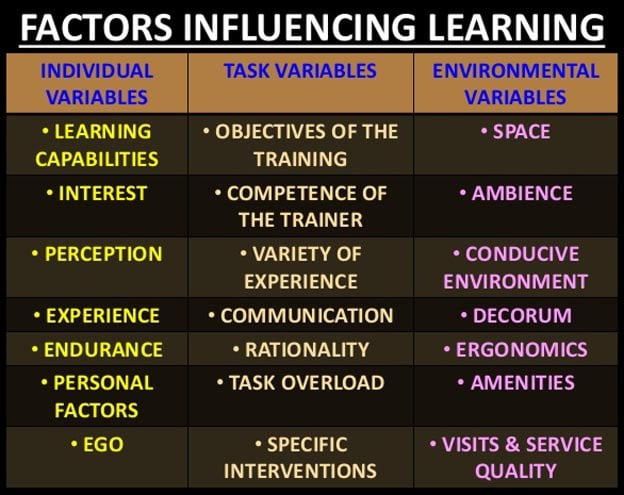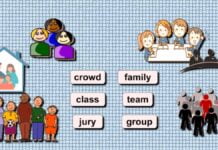Learning is a complex process that defies easy definition and description. Human learning is influenced by the family, the community, the school and the societal structure in which the child is born and brought up. Apart from this, the child’s psychological characteristics have a strong influence on his/ her ability to learn as well as how he/ she learns. All these personal and environmental factors play a crucial role in influencing student learning. Thus learning can be defined as a function of the interaction of personal (psychological) and environmental factors and can be mathematically represented as
L = f (EF × PF)
where L = Learning; f = Function; EF = Environmental Factors; PF = Personal Factors.

Personal factors (psychological factors) are the individual factors like intelligence, motivation, attitudes, etc. which predispose an individual towards learning. Environmental factors, on the other hand, are those contextual factors, which highlight the role of the environment in learning, such as the socio-emotional, societal, cultural and other school-related factors. Although these factors represent two different categories, they operate in a common system. The learner and the learning process can only be completely understood regarding the interaction of both personal and environmental factors.
Some of the personal factors that influence the learning process can be classified as intelligence, age and maturation, motivation, sensation and perception, fatigue and boredom, emotional condition, needs and interests, attention, aptitude, attitude etc.
Intelligence
Intelligence can be defined as the ability to learn about, learn from, understand, and interact with one’s environment. This general ability consists of several specific abilities, which include adaptability to a new environment or changes in the current environment; capacity for knowledge and the ability to acquire it; capacity for reason and abstract thought and to comprehend relationships; ability to evaluate and judge; and capacity for original and productive thought. Therefore in operational terms, it is a capacity or ability for problem-solving, thinking, reasoning, relating to others, dealing with emotions, developing interests, a sense of right and wrong and living in consonance with our environment.
Age and Maturation
Learning is directly dependent upon age and maturation. No learning can take place unless the individual is matured enough to learn. Some children can learn better at an earlier age while others take more time to learn the same content. A learner’s readiness and willpower to learn is a great deciding factor of his/her results in learning. It is presumed that if an individual has the will to learn, then automatically he/she will find ways for effective learning. In other words, the learner should be mature enough to learn a particular skill or task. This means that there is an optimal or most appropriate time for each individual to learn a specific skill or a concept with ease and efficiency. This appropriate time comes when one’s physical, neural and intellectual aspects of development have advanced enough to enable one to perceive the problem and solve it with relative ease and comfort. Maturation has to be thus understood as a natural process of unfolding of the development stages, resulting in functionally preparing an individual to acquire mastery over his/her environment.

Motivation
Motivation is the heart of the learning process. Motivation may be regarded as something which prompts, compels and energizes an individual to act or behave in a particular manner, at a particular time for attaining some specific goals or purposes. Motivation may also be formally defined as an internal state that arouses, directs and maintains behaviour. It generates the will in an individual to do something. Adequate motivation not only engages the student in an activity that results in learning but also sustains and directs learning. Two types of motivation commonly recognised are intrinsic and extrinsic motivation. Intrinsic motivation arises when the resolution of tension is to be found in mastering the learning task itself: the material learned provides its reward. For example, the student who studies the construction of model aeroplanes diligently so that he can make a model is experiencing a kind of intrinsic motivation. Extrinsic motivation occurs when a student pursues a learning task, but for reasons” which are external. If a student engages in the construction of model aeroplanes because he thinks it will please his father, who is an ex-pilot rather than because of intrinsic motivation.
Sensation and Perception
Apart from the general health of the students, sensation and perception are the psychological factors that help in learning. Sensation and perception are the basis of all cognitive learning. Weaker the power of perception, lesser the amount of learning. The sensation is at the core of perception. There are five sense organs i.e., skin, ears, tongue, eyes and nose. These sense organs are the gateways of knowledge and help in the perception of various stimuli in the environment. Any defect in any of the sense organs will affect learning and hence, the acquisition of knowledge.
Fatigue and Boredom
The difference between the two is that fatigue is mental or physical tiredness that decreases efficiency and competency to work. Boredom, on the other hand, is a lack of desire or an aversion to work. Such an aversion makes one feel fatigued without being fatigued. Studying seldom causes fatigue. It is mainly boredom which, besides causing the impression of fatigue, decreases student efficiency in learning.
Emotional Conditions
Our emotions play quite a significant role in guiding and directing our behaviour. Desirable emotional conditions enhance the quality and speed of learning. Happiness, joy and satisfaction are always favourable for any type of learning. Adverse emotional conditions, on the other hand, hinder learning. Many studies have established the fact that emotional strain, stress, tensions, disturbances, etc., are extremely inimical to scholastic pursuits. Different psychologists describe emotions as some sort of feelings or affective experiences which are characterized by some physiological changes that generally lead them to perform some of the other types of behavioural acts. The development of emotions in human beings is largely influenced by the process of maturation and learning.
Aptitude
A student who possesses an appropriate aptitude for a particular subject of study or skill will learn better and retain it for a longer time. On the other hand, he will require a relatively long time to study a subject for which he lacks natural aptitude. He is liable to forget it soon besides feeling bored and unhappy all the time while learning it. Hence it is extremely desirable to analyse the aptitude of students before prescribing courses of study for them.
Attitude
The learning process is also influenced considerably by the attitude of the student. If he is alert, attentive and interested in the material to be learnt he is bound to have a favourable attitude towards it. Attitudes are born out of the process of socialization and Our attitudes towards objects, events and persons may be positive, negative or neutral. For instance, if we are inclined towards reading books, playing cricket, good health fitness etc, we will have a positive attitude towards books, games, going for morning walks, gymnasiums etc.

Needs
A need is the lack of something which, if provided, would facilitate the child’s usual behaviour. The lack of something is experienced by the child. The child then tries to perform that activity which culminates in the satisfaction of the need. Thus, the needs are associated with goals. Among human beings, the needs are relatively permanent tendencies that seek satisfaction in achieving certain specific goals. When these goals are achieved, the particular need is satisfied or met for the time being, but it recurs sooner or later and energises further activity.
Interests
Interests are deep-rooted constructs and are determined by the need structure of an individual. An individual with strong social needs such as belongingness, affiliation and recognition will direct all his/ her energies into activities that enable him/her to fulfil these needs such as meeting people, going to clubs, associations, parties, meetings, etc. Individuals differ a great deal in their patterns of interests because their need structures vary. For some persons, social and emotional needs become the guiding forces, for others, aesthetic or higher cognitive needs may be the preponderant factors. Age variations are also visible. Young children need activity, play, adventure etc. and thus they learn much better through a play way approach. This arouses their interest in studies and helps to sustain their involvement in work. For adolescents and older learners, the needs for affiliation and group belongingness are very high and thus they always show an interest in recreational group activities like parties, picnics, social outings, etc. Interests are, thus, determined by both age-related and human needs factors. They influence not only what one learns best, but also serve to explain why learning becomes inadequate.
Environmental influences begin from the time of the conception of the child in the womb or the mother. Mother’s mental, physical and emotional conditions influence the development of the foetus in the womb. The external environment starts from the time of birth of the child. External environment refers to the surroundings which prevail in home, school and locality. At these places, the child interacts with members of the family, teachers, classmates or peers and neighbours and establishes a relationship with them. The relationship with the members of the society, and the surroundings may affect the development of the child and also the way he learns. Natural surrounding covers the climatic and atmospheric condition. These conditions affect learning directly. It has been found that high temperature and humidity reduces mental efficiency. For a limited time, humidity and high temperature can be tolerated but prolonged humidity and high temperature become unbearable and decrease mental efficiency. Cultural demands and social expectations also influence learning. The spirit of culture is reflected in its social and educational institutions. Children’s learning, therefore, is greatly determined by the demands and expectations of their culture.
Relationship with Teachers, Parents and Peers
The teacher is an important constituent in the instructional process. She/he plays an important role in shaping the behaviour of students. The way he teaches and manages the students affects their learning. Relationship with parents plays a vital role in the learning process of the student. If the child-parent relationship is based on mutual respect and faith, it can provide the child with a congenial atmosphere which in turn can facilitate his/her learning. A distorted and unhealthy environment, on the other hand, adversely affects the learning of the student. A healthy peer group relationship also plays an important role in Learning. Student-student relationship in the classroom, school, society, etc., create a particular type of emotional climate and it solely depends upon their relationships. A sound relationship provides a tension-free environment for the student to learn more and to compete in the class. If the relationship among peers is not good, it adversely affects their learning.
Media Influence on Learning
Media has been considered an important component of transmitting the information. It is economical and has traditionally been used for pedagogical purposes. It is well clear that media are advantageous in enhancing learning among students, but proper use of the media requires the use of well-developed media-specific skills. If these skills are not well developed, the message may be misinterpreted or uncritically received, accepted and responded to. For using media constructively, learners need to learn how to critically interpret words, pictures, maps, diagrams and specialized symbolic expressions. Critical learners can use different media for attaining various educational objectives, chief of which are the following: as a means of entertainment or infotainment i.e. information-cum-entertainment; as a means of enriching classroom learning; as a major learning resource; as a means of developing and refining creative expression; as a means of further development of media-specific sensory skills and higher-order cognitive skills. Constructive use of various media can enable the learners to transform their understanding of their society and themselves, and thus help formal education become more meaningful for every learner.





























